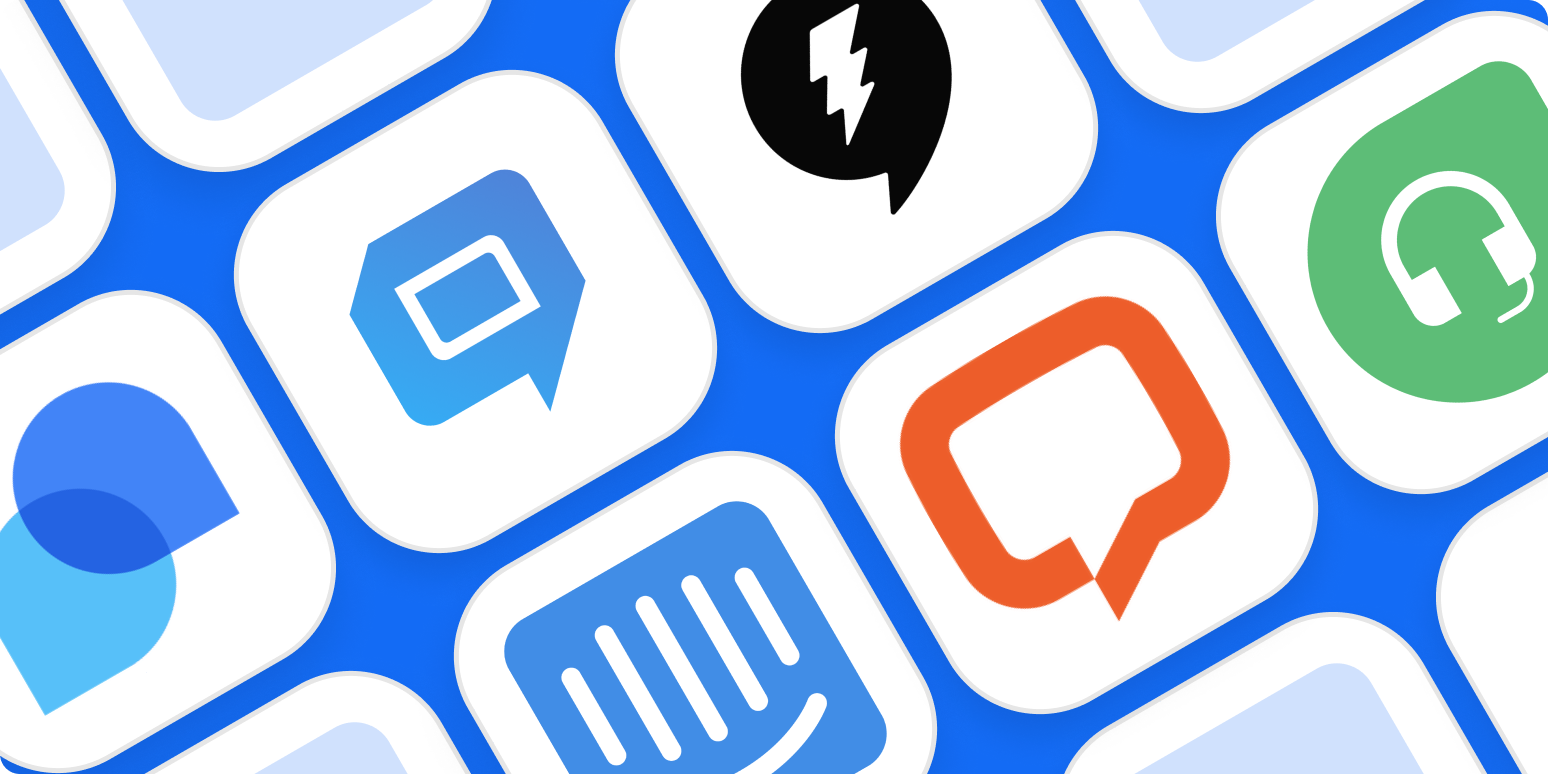Live chat isn’t just for customer support anymore: you’ll now find most companies using chat to nurture leads and drive sales. But the sales chat app market isn’t quite as developed yet, so we wanted to put the options to the test and see who came out on top.
Spend less time on lead management
I spoke to a live chat expert to get further insight into using chat for sales. Then I evaluated dozens of live chat platforms for sales and tested them to figure out which ones are best for different use cases and budgets. Here are the seven best live chat apps for sales.
The best live chat apps for sales in 2021
What makes a great live chat sales app?
Live chat presents an opportunity to provide a better buying experience for visitors and customers—and increased revenue for your business. But not all chat platforms get the job done. Here are the characteristics that I considered most when selecting the apps for this list:
-
Dynamic features. To connect with potential customers, chat has to be dynamic, not static. I’m talking about things like personalized and targeted automations, proactive chats, chatbots, nurturing sequences, lead scoring, forms, and segmentation.
-
Integrations. Integrating live chat into your existing tech stack helps ensure that your data is complete and that your tools are being used efficiently. This means your eCommerce platform, CRM, marketing automation tool, and everything in between. The best sales chat apps offer either native integrations or integrations with a tool like Zapier.
-
Productivity features. These are the tools that make the jobs of chat reps and their managers easier. Things like canned responses, chat transfer, typing indicators, co-browsing, and chat and visitor routing.
-
Reporting. All apps will have basic reports for general chat data, such as total chats, response time, chats by agent, and the like. To track marketing/sales performance, a chat app should also have built-in reporting for lead gen and sales, and even reports for chatbots. And ideally, there’s a native Google Analytics integration to help track any additional data not included in the other reports.
A chat pro’s perspective
To get a better feel for how companies should approach using live chat for sales, I spoke to Joe Bush, CEO of The Chat Shop, a UK-based company that helps businesses increase their leads using chat. Their clients range in size from smaller boutiques to well-known corporations and comprise a broad spectrum of industries. I asked him for his recommendations when using chat for sales.
On personalization
Joe told me that the most important thing you can do is to set up proactive, personalized visitor greetings. He compares it to walking into a retail store where a good salesperson will observe your behavior, looking for the right time and the right message to engage with you in a conversation.
“If the salesperson just says, ‘Hey, how are you?’ the response is rarely as positive as if they say, ‘I can see you’ve been looking at 4K Smart TVs. This one is particularly great for this reason. Are you looking to place it in your bedroom or your front room?'”
On chatbots
All of the platforms in our review have their own chatbots. And while they have their uses, chatbots aren’t ideal for every business. Joe told me that businesses need to consider a few things before investing the time in this technology.
“What we’ve found is the more complex your business is, the less likely a chatbot can add value. And the lower your traffic volume is, the less likely the chatbot makes sense because it takes time and energy to optimize and get it right,” he said.
To his first point, the higher the price of your products or services, the more considered the buying decision. A bot would be fine assisting someone buying $100 in office supplies, making product suggestions, and assisting with checkout. But a visitor looking at $3,000/year software is likely going to want to talk with a human. Joe said that, in this latter case, chatbots should just be a bridge (e.g., do you need pre- or post-sales support?) connecting a visitor with the right person.
Which brings up another point.
On providing value
It’s nice to know who you’re talking to when a visitor initiates a chat on your site. But should you require that visitor to supply a name, email, and even phone number as a condition to chat? Joe doesn’t think so.
“We have to provide value to ask for value,” he said. “We would never ask for someone’s email address, phone number, or contact details upfront because why would they give them to us? We haven’t given them anything for them to want to give their info to us.”
This approach may or may not make sense for your business. And as you’ll see on our list of the best sales chat apps, this is just one of the many decisions you’ll have to make when deploying live chat.
Best live chat app for sales-related chatbots
Tidio (Web, Windows, Mac, iOS, Android)
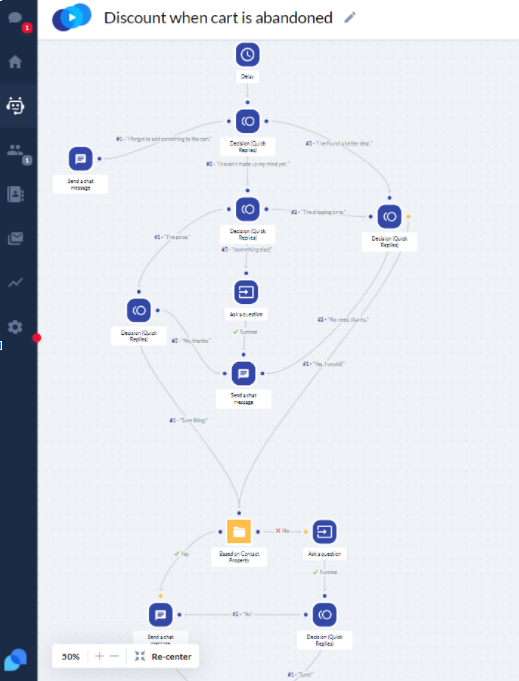
Save an abandoned cart. Offer free shipping to close a sale. Upsell and cross-sell. These are just some of the many pre-made (but customizable) chatbots included with Tidio. You can also start from scratch to create your own using their bot builder.
When you click on the bot icon in the menu, you’ll get a list of any bots you’ve created, the engagement percentage, and other usage data. Scroll down to see categories of different bots: generate leads, boost online sales, and so on. Hover over a bot, such as the “discount when cart is abandoned” one, to test or customize it.
As you’re customizing, you’ll see a decision tree with steps that you can edit, delete, or add to with triggers, conditions, and actions that you can drag onto the tree. Before you launch your bot, you can test it out. If you’ve made a mistake, you’ll be shown where and what’s wrong. If not, you can see it in action before you save it and go live.
If you get stuck anywhere, Tidio’s knowledge base is an excellent resource for tackling anything in the app with extensive step-by-step instructions and images for each feature. When setting up chatbots (you can have multiples operating at once), the chat builder automatically lets you know when there might be a conflict between bots. For example, I was creating my second bot for first-time visitors, and I was alerted that I already had a bot targeted to these visitors, which would cause multiple messages to the same visitor. Pretty neat.
You can get even more from Tidio by connecting it to Zapier and automating your live chat workflows. Do things like add new Tidio leads to an email list so you can ditch the manual work of tracking your leads.
Tidio Price: Free for 3 users; from $18/month for 1 user for live chat with chatbots. Add-on plans with additional features start at $10/month.
Best live chat sales app for ease of use
HelpCrunch (Web, iOS, Android)
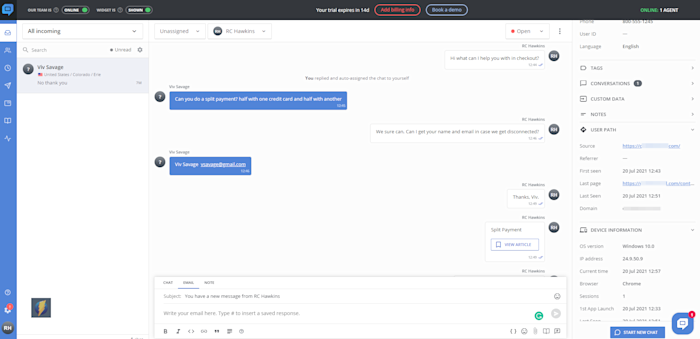
After testing dozens of chat apps, it’s a treat to land on one that feels like it was designed for you to succeed and enjoy yourself (or at least feel less job-like). HelpCrunch has helpful tutorials, an intuitive UI, and automated messages to assist with lead gen and closing sales. All of this comes in a platform that even the least technically-minded will find easy to use.
If the clear step-by-step instructions for installing the widget and setting up the features aren’t enough, just click the circled question mark in the menu bar to get a video explanation, links to articles and the help center, and a contact support option. Even some of the more advanced features like automated messages proved unchallenging.
Here’s an example: I wanted to display an automated chat message for first-time visitors on a pricing page, so I selected that pre-made template (pricing page visit). Then I followed the instructions down the screen as prompted: title, sender, send to, and when to show the message (i.e., team is/is not online). Then I wrote my message and created the rules for who would see the message (new visitors) and under what conditions (on the pricing page for more than five minutes). With the little info bubbles and help links along the way, it would be tough not to get this set up right the first time.
You can also create your own auto messages and select from several dozen rules for which type of visitor sees the message. All of these messages are tracked for sent, opened, clicked, and replied in a grid showing which ones are active or just drafts. And you can create pop-ups using nearly the same process as auto messages. These will appear on your pages when and where you want, firing for the conditions you choose.
Connecting HelpCrunch to Zapier means you can automate your live chat workflows. Do things like adding new chat customers to your email list, or get notified in Slack whenever a customer unsubscribes.
HelpCrunch Price: From $12/user/month for live chat; from $23/user/month for live chat plus email.
Best live chat sales app for automated visitor personalization
Drift (Web, Mac, Windows, iOS, Android)
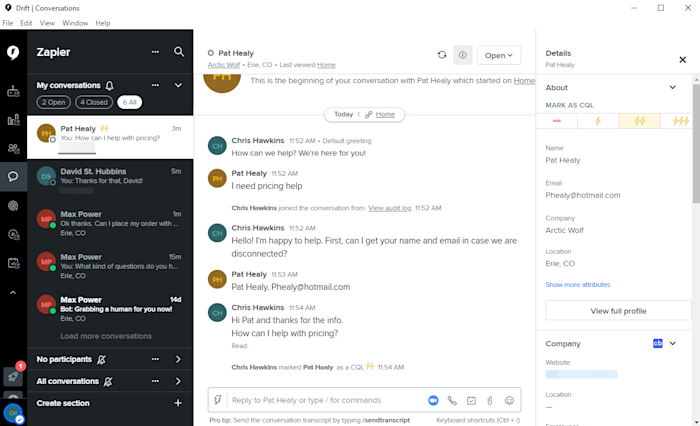
Drift is one of the few live chat platforms specifically designed for sales and marketing or, as the company puts it, “revenue acceleration.” It combines live chat and chatbots with automated personalization tools, such as targeted chat messaging, visitor data, and account prioritization. And this is just the jet stream view; there are dozens of features that bring all this together.
The platform is loaded with features, so I was pleasantly surprised that both navigation and setup were relatively easy. Once I designed my basic chat widget, it was time to get acquainted with the heart of Drift: automated workflows called Playbooks that proactively send messages to targeted visitors on your site. Essentially, you’re automatically starting a chat conversation tailored to the characteristics of your visitor—i.e., where they are in your sales or marketing funnel.
For a Bot Playbook, you’d create a target audience (e.g., industry, company size, Salesforce list), select the type of conversation (e.g., retargeting, pricing), and then customize the pre-made bot flow via decision tree format.
The flow starts with a personalized greeting (including the visitor’s name) and options for the visitor to click, for example, “Yeah, we’re almost ready to go” or “Just checking out the site again.” The conversation branches based on what’s clicked next. The only action you really need to take is to add your company-specific responses: “I want to see a demo of [Acme’s Flux Capacitor].” or “I want to find out how others are using [Acme’s Flux Capacitor].” That said, Drift gives you complete control over the questions, responses, and flow so you can start from scratch if needed. Along the way, you can capture a visitor’s email, automatically schedule a sales call, send collateral, or whatever your goal for the conversation happens to be. Once you’re done, you can preview the bot before publishing.
Drift’s reporting shows you how your Playbooks are performing with impressions, conversations started, emails captured, and meetings booked. With bots, you’ll get additional data on A/B tests (easy to set up) and where your visitors are dropping off during a Playbook. You’ll also get a bird’s-eye view of how your Playbooks are working across your site, including your highest performing pages, industries, and other parameters relevant to your audience. Chat conversations are also tracked, letting you see specific keywords mentioned and the outcomes of those conversations—this is a good way to see what’s working during your chats.
Connect Drift to Zapier so you can make sure it’s talking to your other apps. Do things like automatically add new Drift leads to your CRM, create customer support tickets when Drift conversations are closed, and more.
Drift Price: You’ll need to speak to Drift sales for a custom quote.
Best live chat sales app for nurturing leads
Intercom (Web, iOS, Android)
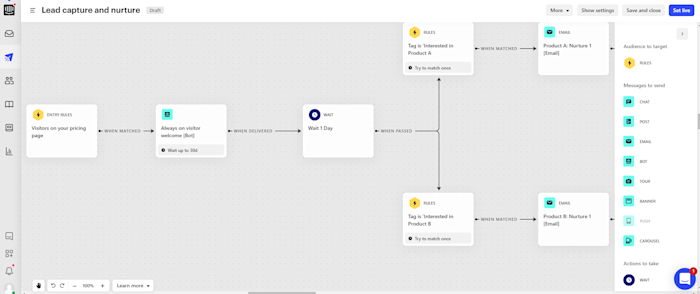
Popular chat platform Intercom has expanded its capability recently with the addition of a nurturing feature called Series. This visual campaign builder lets you capture leads, re-engage inactive users, and upsell using chat, email, mobile carousels, and other assets. They’re easy to build with no code or technical expertise. (Note: I was using a developer’s version to test, which meant some of the capabilities weren’t available to me, but I was still able to give it a thorough test.)
I was able to create custom banners, chat widgets, and bots, all targeted to website visitors and designed to start conversations. In just a few minutes, I made a banner to advertise a webinar; included a link to a signup page; and set rules on visitors (e.g., first time, number of web sessions), page visited, and when it would pop up. Then it was on to building campaigns.
You can start a nurture campaign from scratch or pick one of the pre-built (but customizable) nurture Series, using Blocks called rule, content, wait, and tag. Here’s an example of a nurture series using the different Blocks.
-
Rule: A first-time visitor who spends at least 20 seconds on your pricing page.
-
Content: A bot asks the visitor which product they’re interested in (e.g., Product A or Product B), asks for an email, and sends a link with more info.
-
Wait: The time set (e.g., one day) until another phase in the nurture series.
-
Content: A bot sends an email sharing a success story from a customer using that specific product.
-
Tag: If the visitor opens the email, it tags them as a sales opportunity. Tags can be used to segment visitors, adding or exiting them from other nurture series.
For each content block, you can set goals such as increasing web sessions, collecting emails, or demo signups. Then you can track goal percentage for each Series, and the Reporting tab will show new leads acquired and their sources, among other things. You can also report on things like meetings booked, revenue sources (e.g., bot, message), and revenue closed for each teammate.
You can make Intercom even more powerful by connecting it to the rest of your tech stack with Zapier. Automatically log new Intercom users in your CRM or email list, send leads from other sources to Intercom, and more.
Intercom Price: You will need to speak to Intercom sales for a quote.
Best live chat sales app for lead scoring
Zoho SalesIQ (Windows, Mac, iOS, Android)
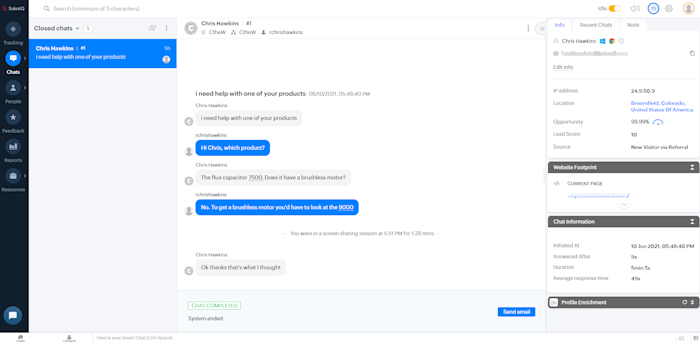
With both lead and company scoring, Zoho SalesIQ gives sales reps a way to identify quality leads—and chat proactively—any time a visitor lands on your website. The ability to score leads and prioritize “live” visitors for proactive chats makes this app an attractive option, especially for B2Bs.
You can define the criteria for how your visitors and contacts are evaluated for their sales readiness. There’s a list of rules—visitor source, time on site, etc.—with preassigned positive or negative values from -999 to 999. Adjust each score based on how much you feel an action adds or subtracts value from a visitor. For example, you might want to give visitors 100 points for visiting your pricing page and 50 points if you’ve chatted with them two times in the past. Once your rules are set, you’re ready to engage with your site visitors.
In the Rings view, you’ll get a visual of all current site visitors arranged on different priority rings based on your predefined conditions. Lead priority drops as you move from inner to outer rings, so the visitors on the innermost ring(s) are the ones you may want to start a proactive chat with, as they’re presumably most qualified. Click on any visitor’s icon to pull up their lead score and chat history, then start a proactive chat.
Company scoring lets you target visitors by company based on criteria you set for things like size and industry (you assign a positive or negative point value for each criterion based on your needs).
As for the chatbot builder, it’s laid out like a decision tree. Before you start, create a library of FAQs and articles (e.g., “what’s your warranty?”) that your bot can respond with. Then when you create your bot, it will offer you this library of FAQs to serve up to visitors. The warranty example worked perfectly when I typed “warranty” in the bot and it returned a link to the article I created.
One downside: very few of the features in Settings had explanations or links for further context—with a complex app category, this would have been helpful.
Zoho SalesIQ Price: Free for 3 users; paid plans start at $7/month/user
Best live chat for a la carte feature pricing
LiveChat (Web, Windows, Mac, iOS, Android)
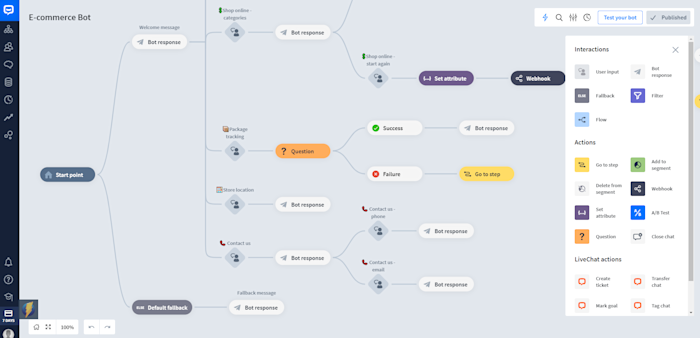
If you’re unsure about the potential of chat and how your company might use it to increase sales and improve service, LiveChat is a good place to start. The platform contains a nice assortment of sales-related features in their base plans, and they offer advanced add-on features and products that can help grow your chat channel as your business needs change.
Included with LiveChat is the targeted messages feature, which lets you create and target chat messages to certain segments, such as first-time visitors on your checkout page (e.g., “shipping is on us for this order”). These widgets are fairly customizable—add image, text, button (with links to URL, chat, and call)—though I’d like to see more options for designing the widget to match your website’s theme. Other use cases include coupons, event registration, announcements, and sales. You can also gather visitor info with basic pre-chat surveys using dropdowns and multiple-choice lists.
LiveChat offers three integratable products: ChatBot, HelpDesk, and KnowledgeBase. ChatBot (from $42/month), the obvious choice for lead gen, lets you create bots from scratch or use one of the pre-built Stories (e.g., eCommerce), which presents different paths visitors can take based on their goals. For example, if a visitor wants to see what’s on sale, the bot can display images of those items with links to add to a cart (eCommerce integration required). Other bot-assisted options include tracking packages, shopping for specific products, and speaking to a sales rep. All Stories are customizable and relatively easy to set up thanks to the decision tree format.
Along with these products, you can add upgrades from LiveChat and third-party integrations from the marketplace. For example, Rich Messages ($2.50/month/agent) lets you create carousels of products or services, displaying them in the chat widget to your visitors. Curious how your sales reps are handling their chats? The Super Vision add-on ($49/month) lets you monitor up to eight chats in real time from one screen. To find answers to your burning customer questions, create Surveys ($2.50/month/agent) and install them in your chat widget. Use them in your chat greetings, embed them in bots, and then analyze the results.
There are also dozens of third-party integration options from vendors such as Salesforce, Zoom, Slack, Stripe, and more. Most of these are free to integrate as long as you have subscriptions, but some, like Google Analytics ($5/month), are not. If there’s no native integration, you can use Zapier to connect LiveChat with thousands of apps and do things like get Slack messages for new chats or add new chats to your CRM or email list.
LiveChat Price: From $16/month/user; add-ons start at $2.50/month. ChatBot starts at $42/month and HelpDesk at $4/month/user; KnowledgeBase is a flat $39/month.
Best live chat app for sales and service combined
Freshdesk Messaging (Web, Mac, Windows, iOS, Android)
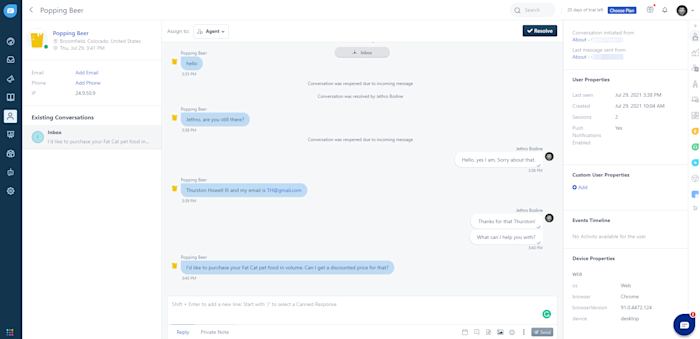
If you’re on the fence about how you want to use live chat—mostly for sales? or primarily service?—Freshdesk Messaging (formerly Freshchat) provides solid functionality for both departments. One of the many apps in the Freshworks family, it combines plenty of sales and service features into one package, making it the ideal choice for companies needing a good balance of the two. Let’s look at the service side first.
To start, design a chat widget for each of your teammates with a personal touch. Add a name, picture, and short “about me” description to let your visitors know they’re dealing with a human. For each agent, you can specify a skill level, which will correspond to the number of active conversations each can engage in. So for a beginner level, you might limit this role to four conversations at a time, while an expert could handle up to eight. This will be used to evaluate and assign chats using their system—load-based or round-robin—to automatically push chats to agents.
A few other service features that stood out are sending rich messaging (images, videos, FAQs); bulk actions for assigning and resolving chats; and co-browsing, which worked well when I tried it. Another feature I liked—that was different from some of the other apps on this list—is their FAQs. You can create help articles for different categories, include them in your chat widget, and have them open up within the widget rather than taking your visitors to another page or site.
Now on to the proactive messages. I was able to easily create a chat message for a free shipping discount that pops up after a visitor has been on the homepage for 15 seconds. You can add as many filters as you want for conditions, such as pages visited, location, and events. In another example, I created a message targeted to those who haven’t been on the site in three months, offering them free shipping on their next purchase. There’s a similar campaign for sending triggered emails, but I couldn’t get this feature to work for me.
Freshdesk Messaging has a nice selection of pre-built and custom reports for tracking chat details and even campaign information (for bots), but it doesn’t have a native Google Analytics integration.
Freshchat Price: Free for 100 agents (no free bot sessions). Paid plans start at $15/users/month; $19/month flat fee for some automation features.
[adsanity_group align=’alignnone’ num_ads=1 num_columns=1 group_ids=’15192′]
Need Any Technology Assistance? Call Pursho @ 0731-6725516

